-
 Bitcoin
Bitcoin $82,373.9697
-3.36% -
 Ethereum
Ethereum $1,851.6745
-2.19% -
 Tether USDt
Tether USDt $0.9995
-0.01% -
 XRP
XRP $2.1068
-5.67% -
 BNB
BNB $604.3688
-4.21% -
 Solana
Solana $125.7138
-4.63% -
 USDC
USDC $1.0000
0.01% -
 Dogecoin
Dogecoin $0.1713
-5.80% -
 Cardano
Cardano $0.6723
-4.55% -
 TRON
TRON $0.2343
1.95% -
 Toncoin
Toncoin $3.6885
-8.69% -
 Chainlink
Chainlink $13.7038
-4.56% -
 UNUS SED LEO
UNUS SED LEO $9.5887
-1.08% -
 Avalanche
Avalanche $20.0178
-2.55% -
 Stellar
Stellar $0.2684
-2.91% -
 Shiba Inu
Shiba Inu $0.0...01276
-4.74% -
 Sui
Sui $2.3137
-9.11% -
 Hedera
Hedera $0.1708
-7.54% -
 Litecoin
Litecoin $86.3372
-2.01% -
 Polkadot
Polkadot $4.0851
-4.64% -
 MANTRA
MANTRA $6.3082
-1.10% -
 Bitcoin Cash
Bitcoin Cash $304.0264
-2.74% -
 Bitget Token
Bitget Token $4.5892
-3.43% -
 Pi
Pi $0.8035
-3.52% -
 Dai
Dai $0.9999
-0.01% -
 Ethena USDe
Ethena USDe $0.9992
0.03% -
 Hyperliquid
Hyperliquid $12.6865
-8.10% -
 Monero
Monero $215.4800
-2.52% -
 Uniswap
Uniswap $6.0913
-2.75% -
 Aptos
Aptos $5.3753
-2.22%
What is the difference between PoW (proof of work) and PoS (proof of stake) in blockchain?
Proof-of-Work (PoW) and Proof-of-Stake (PoS) are blockchain consensus mechanisms; PoW is energy-intensive but offers strong security, while PoS prioritizes efficiency but relies on economic incentives for security.
Mar 24, 2025 at 07:14 pm
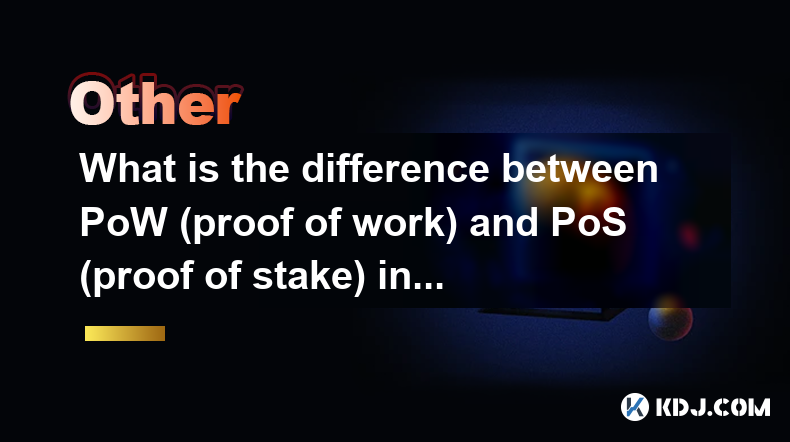
Key Points:
- Consensus Mechanisms: Both Proof-of-Work (PoW) and Proof-of-Stake (PoS) are consensus mechanisms used to validate transactions and add new blocks to a blockchain. They differ significantly in their approaches.
- Energy Consumption: PoW is notoriously energy-intensive, requiring significant computational power to solve complex cryptographic puzzles. PoS, on the other hand, is significantly more energy-efficient.
- Security: Both mechanisms offer security, but their vulnerabilities differ. PoW is resistant to 51% attacks due to the high computational cost, while PoS relies on the stake held by validators to deter malicious activity.
- Transaction Speed: PoS generally offers faster transaction speeds compared to PoW due to its less computationally intensive nature.
- Staking vs. Mining: PoW relies on "mining" – solving complex problems to validate transactions. PoS relies on "staking" – locking up cryptocurrency to validate transactions and earn rewards.
What is Proof-of-Work (PoW)?
Proof-of-Work is a consensus mechanism that requires miners to solve computationally intensive cryptographic puzzles to validate transactions and add new blocks to the blockchain. The first miner to solve the puzzle gets to add the block and receives a reward in cryptocurrency. This process requires significant energy consumption, as miners compete to solve the puzzles using specialized hardware. Bitcoin utilizes PoW.
What is Proof-of-Stake (PoS)?
Proof-of-Stake is a consensus mechanism that selects validators based on the amount of cryptocurrency they "stake" – locking up their coins in a smart contract. The more cryptocurrency a validator stakes, the higher their chance of being selected to validate transactions and add new blocks to the blockchain. This process is significantly more energy-efficient than PoW. Examples include Cardano and Solana.
How does PoW work in detail?
- Miners compete to solve complex cryptographic hash puzzles.
- The first miner to find the solution adds the block to the blockchain.
- The miner receives a block reward and transaction fees.
- The process repeats for every new block.
How does PoS work in detail?
- Users stake their cryptocurrency to become validators.
- Validators are selected randomly based on the amount of staked cryptocurrency.
- Selected validators propose and validate new blocks.
- Validators earn rewards for their participation.
- Validators who act maliciously risk losing their staked cryptocurrency.
Energy Consumption Comparison:
PoW consumes vast amounts of electricity due to the intense computational power required for mining. This has raised environmental concerns. PoS, in contrast, has significantly lower energy consumption because it doesn't require the same level of computational power. The energy used is primarily for network communication and maintaining the blockchain.
Security Comparison:
PoW is generally considered more secure against 51% attacks due to the high computational cost required to control a majority of the network's hashing power. In PoS, the security relies on the economic incentives of validators. A large stake is required to attempt a 51% attack, making it economically unviable for most attackers. However, vulnerabilities exist in both systems, and ongoing research focuses on improving their security.
Transaction Speed and Scalability:
PoW blockchains often experience slower transaction speeds due to the time required to solve the cryptographic puzzles. PoS blockchains generally achieve faster transaction speeds and higher scalability due to their less computationally intensive nature. This leads to improved user experience and potentially lower transaction fees.
Staking Rewards vs. Mining Rewards:
In PoW, miners receive block rewards and transaction fees for successfully mining blocks. In PoS, validators receive rewards for validating transactions and proposing blocks, proportional to their stake. These rewards incentivize participation and help secure the network. The reward structures vary significantly across different PoS blockchains.
Delegated Proof-of-Stake (DPoS):
DPoS is a variant of PoS where token holders elect delegates to validate transactions on their behalf. This allows for more efficient validation and participation from a wider range of users who may not have the technical expertise or resources to run a full validator node.
Common Questions:
Q: Is PoS better than PoW?
A: There is no universally "better" system. PoW offers strong security against 51% attacks due to its computational intensity, but at the cost of high energy consumption. PoS is more energy-efficient and often faster, but its security relies heavily on the economic incentives of validators. The optimal choice depends on the specific priorities of the blockchain.
Q: What are the risks associated with PoS?
A: Risks associated with PoS include the potential for centralization if a small number of large stakeholders control a significant portion of the stake. Furthermore, sophisticated attacks targeting the consensus mechanism or validator selection process are possible, though less likely than in PoW.
Q: What are the environmental implications of PoW?
A: The significant energy consumption of PoW has raised significant environmental concerns, prompting research into more sustainable alternatives like PoS and other consensus mechanisms. The carbon footprint of PoW blockchains is a subject of ongoing debate and research.
Q: Can PoW and PoS be combined?
A: Hybrid approaches combining elements of both PoW and PoS are being explored to potentially leverage the strengths of both systems, such as improving security while reducing energy consumption. These hybrid models are still under development and testing.
Disclaimer:info@kdj.com
The information provided is not trading advice. kdj.com does not assume any responsibility for any investments made based on the information provided in this article. Cryptocurrencies are highly volatile and it is highly recommended that you invest with caution after thorough research!
If you believe that the content used on this website infringes your copyright, please contact us immediately (info@kdj.com) and we will delete it promptly.
- Bitcoin and crypto prices have dropped back as inflation fears and U.S. president Donald Trump’s tariff threats
- 2025-03-29 20:50:12
- XYZVerse ($XYZ) Project Merges the Worlds of Sports and Crypto, Attracting Significant Investor Interest
- 2025-03-29 20:50:12
- We're Already Looking for the Best Altcoins to Buy After Kip Herriage Pushed for GameStop to Pour $2.5B into Bitcoin
- 2025-03-29 20:45:11
- Bitcoin (BTC) price drops to the $80k range as it continues trading in a downtrend and falls 4%
- 2025-03-29 20:45:11
- Jagruta devi templay
- 2025-03-29 20:40:13
- Mutuum Finance (MUTM) Tokenizes Crypto Lending, Aims to Disrupt the Market
- 2025-03-29 20:40:13
Related knowledge
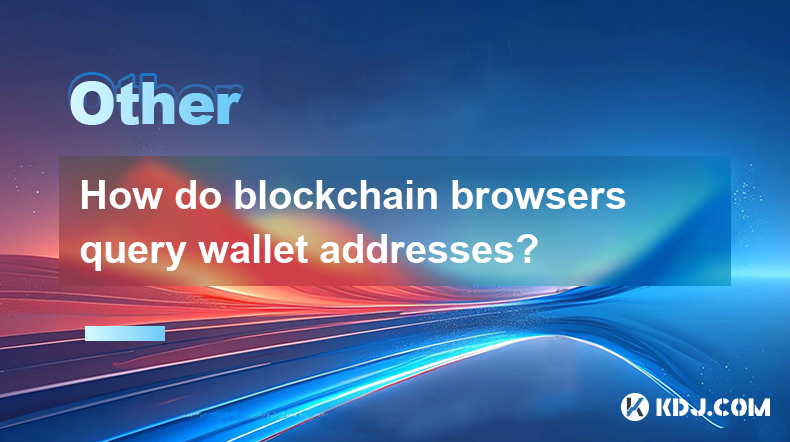
How do blockchain browsers query wallet addresses?
Mar 29,2025 at 05:21pm
Understanding Blockchain Explorers and Wallet Address QueriesBlockchain browsers, often called blockchain explorers, are essential tools for interacting with and investigating blockchain networks. They provide a user-friendly interface to view transaction history, block information, and most importantly, the details associated with specific wallet addr...
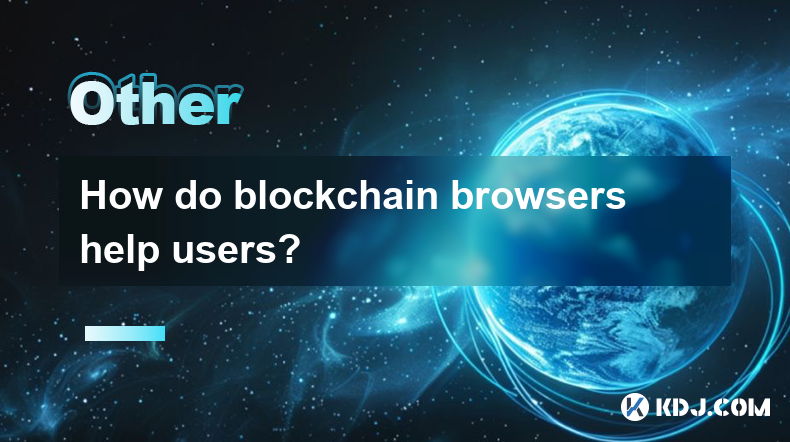
How do blockchain browsers help users?
Mar 29,2025 at 08:28am
Understanding the Role of Blockchain BrowsersBlockchain browsers are specialized tools designed to interact with blockchain networks. Unlike traditional web browsers like Chrome or Firefox, they provide a user-friendly interface for exploring and interacting with the decentralized world of cryptocurrencies and blockchain applications. They offer functi...
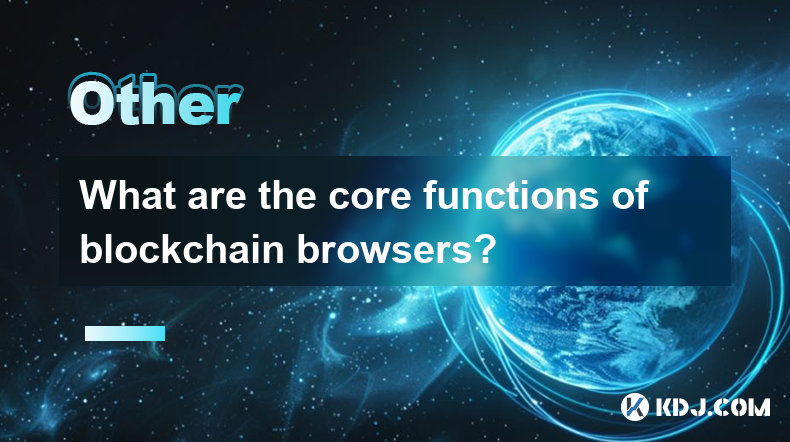
What are the core functions of blockchain browsers?
Mar 29,2025 at 01:50pm
Exploring the Functionality of Blockchain BrowsersBlockchain browsers are specialized tools designed to interact with and explore various blockchain networks. Unlike traditional web browsers, they offer functionalities specifically tailored to the decentralized and transparent nature of blockchain technology. They provide users with a user-friendly int...
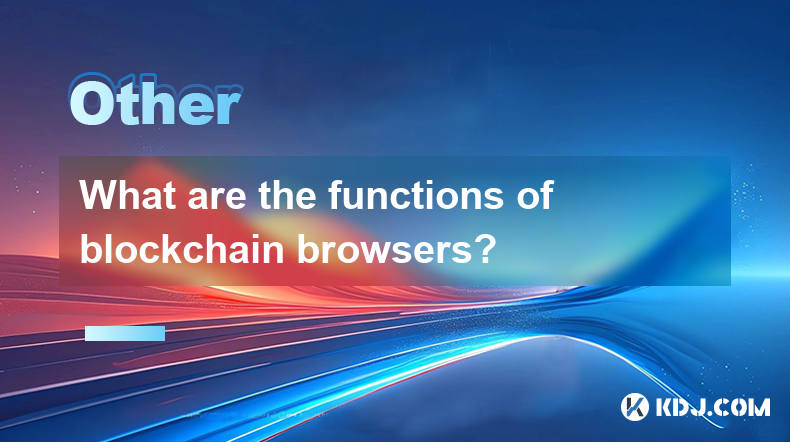
What are the functions of blockchain browsers?
Mar 29,2025 at 07:14am
Exploring the Functionality of Blockchain BrowsersBlockchain browsers are specialized tools designed to interact with and explore various aspects of blockchain networks. Unlike traditional web browsers, they provide functionalities specifically tailored for navigating and understanding the decentralized nature of blockchain technology. They are crucial...
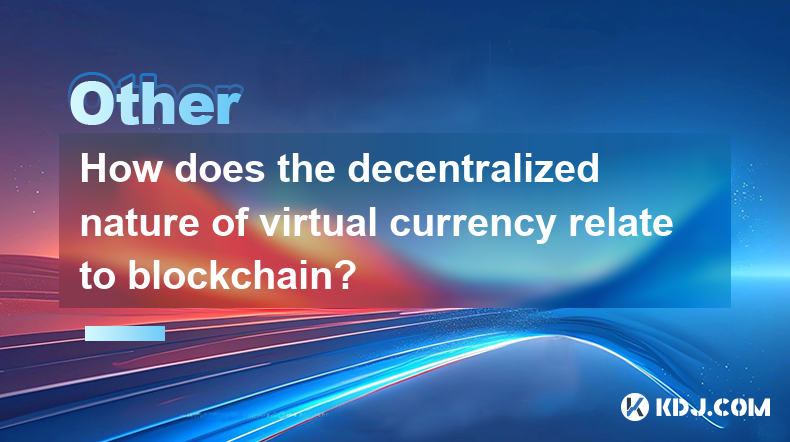
What is the relationship between the decentralized characteristics of virtual currencies and blockchain?
Mar 28,2025 at 06:00pm
In the wave of digital finance, virtual currency attracts everyone's attention with its unique charm, and its decentralized characteristics have become the key to distinguish it from traditional currencies. So what is the close connection between the decentralized characteristics of virtual currencies and blockchain? Don't worry, let's find ...

How does "cross-chain bridge" of blockchain work?
Mar 28,2025 at 03:15pm
Understanding Cross-Chain Bridges in the Cryptocurrency WorldCross-chain bridges are crucial infrastructure in the burgeoning cryptocurrency ecosystem. They facilitate the transfer of digital assets between different blockchain networks, each with its unique architecture and functionalities. This ability to move assets across chains opens up a world of...

How do blockchain browsers query wallet addresses?
Mar 29,2025 at 05:21pm
Understanding Blockchain Explorers and Wallet Address QueriesBlockchain browsers, often called blockchain explorers, are essential tools for interacting with and investigating blockchain networks. They provide a user-friendly interface to view transaction history, block information, and most importantly, the details associated with specific wallet addr...

How do blockchain browsers help users?
Mar 29,2025 at 08:28am
Understanding the Role of Blockchain BrowsersBlockchain browsers are specialized tools designed to interact with blockchain networks. Unlike traditional web browsers like Chrome or Firefox, they provide a user-friendly interface for exploring and interacting with the decentralized world of cryptocurrencies and blockchain applications. They offer functi...

What are the core functions of blockchain browsers?
Mar 29,2025 at 01:50pm
Exploring the Functionality of Blockchain BrowsersBlockchain browsers are specialized tools designed to interact with and explore various blockchain networks. Unlike traditional web browsers, they offer functionalities specifically tailored to the decentralized and transparent nature of blockchain technology. They provide users with a user-friendly int...

What are the functions of blockchain browsers?
Mar 29,2025 at 07:14am
Exploring the Functionality of Blockchain BrowsersBlockchain browsers are specialized tools designed to interact with and explore various aspects of blockchain networks. Unlike traditional web browsers, they provide functionalities specifically tailored for navigating and understanding the decentralized nature of blockchain technology. They are crucial...

What is the relationship between the decentralized characteristics of virtual currencies and blockchain?
Mar 28,2025 at 06:00pm
In the wave of digital finance, virtual currency attracts everyone's attention with its unique charm, and its decentralized characteristics have become the key to distinguish it from traditional currencies. So what is the close connection between the decentralized characteristics of virtual currencies and blockchain? Don't worry, let's find ...

How does "cross-chain bridge" of blockchain work?
Mar 28,2025 at 03:15pm
Understanding Cross-Chain Bridges in the Cryptocurrency WorldCross-chain bridges are crucial infrastructure in the burgeoning cryptocurrency ecosystem. They facilitate the transfer of digital assets between different blockchain networks, each with its unique architecture and functionalities. This ability to move assets across chains opens up a world of...
See all articles






















































































